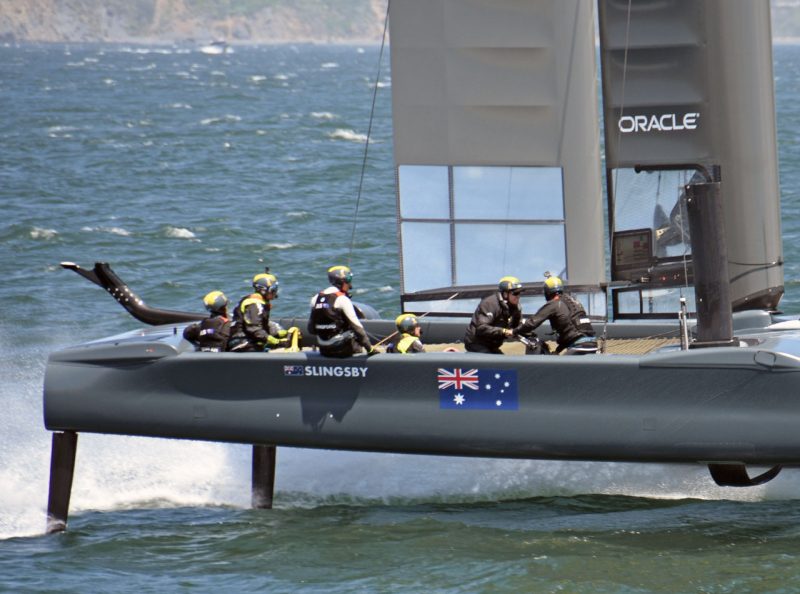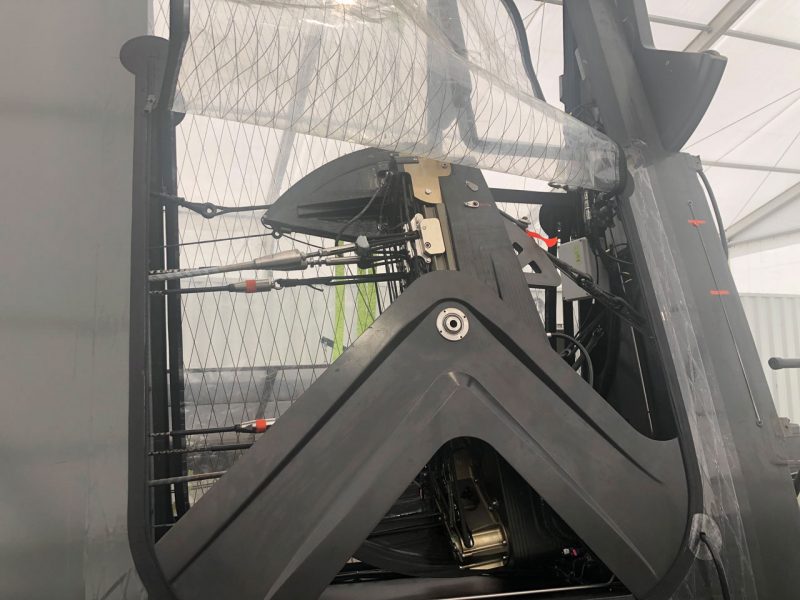
About those SailGP F50 Cats
As the French SailGP team wrote in their latest press release, “Il fait frisquet à Frisco.” They’re comparing the relatively mild conditions for the first act of the series in Sydney to the brisk conditions in the Frisky City for the second act this weekend. This afternoon’s activities will center around official practice racing. Fleet racing on Saturday will lead up to a match race between the top two teams on Sunday.
The Crews
On Media Day, SailGP’s Tom Herbert-Evans served as announcer, calling play-by-play and answering reporters’ questions. He explained the five onboard crew positions: “Starting from the stern, the first person you’ll encounter is the helmsperson, the driver. The next person is the wing trimmer. The third person is the flight controller, who’s fully focused on the maneuvers, the tacks and the jibes, keeping the boat entirely clear. If you see one of the boats crash down, that’s because of a lack of coordination between the driver and the flight controller — or the sea state going into the maneuver. Up front you have grinders. They’re actually trimming some other systems onboard, as well as turning the drum that controls the wing sheet. For America’s Cup 34 in San Francisco, there were about 13 crewmembers. There were a lot of people pumping the hydraulics that move the big hydrofoils up and down in the last event. This time all those are battery-operated.”

The need for brute force has been diminished from the last two America’s Cups, but only one team has a woman onboard. Olympic gold medalist Marie Riou serves as flight controller for the French team. Riou, you may recall, crewed on Dongfeng Race Team, winning the last Volvo Ocean Race.
“The posture of the sailors, when they’re standing more upright in the boat, it means they’re more comfortable. When they’re crouching down, it means they’re holding on for dear life. When they’re going upwind, they’re experiencing about 60 mph of apparent wind. Kind of like putting your head out the window on the highway. So they crouch down to try to get rid of the aero drag as well.”
Foiling 50-ft Catamarans
SailGP’s weapon of choice is no ordinary beach cat. These are two-ton, true one-design remodels of the craft used in the last America’s Cup. “The platforms and wings are from the AC50, though essentially everything else is different,” explained Christy Cahill, SailGP’s director of communications. “Two boats were built from scratch.”
“Between events, if the teams think they can improve something onboard, they’ll give that feedback to their team heads and then back to the event itself, and they’ll collectively make those improvements,” said Herbert-Evans. “Unlike the America’s Cup and some ocean races that have secretive developments, with SailGP everything is open. We share all the data. If a team’s not doing too well, they get full access to the data. All the boats are identical.
“One of the major improvements is they changed the control system. Now there’s a lot more responsibility on the flight controller. It’s kind of like they’re flying an airplane, but purely using the water to keep the boat hovering, which makes them as fast as possible. You can see the kind of black daggerboards on each boat sticking out of the boats. There are two white lines on them. They’re trying to use those white lines to gauge the safe limits of where they can hydrofoil. If they get too high, you’ll see them have a mega crash and come down splashing into the water. If they’re too low they just go very, very slow. So it’s a fine balance as to what you want to achieve — safety, or getting around as quick as possible.”
Observing the conditions on Tuesday, with wind velocity reaching perhaps 20 knots, we wondered about an upper wind limit. “Next year, we’re going to have an adjustable wing, so we’ll actually be able to go from 18 meters to 24 meters to 28. So we’ll be able to sail in a broader range of conditions,” explained Cahill. “We would just go down to the 18-meter wing if the wind was stronger and up to the 28 if it was really light. If we’d had those in Australia, we would have used the bigger 28-meter wing. These wings are 24 meters — 78-feetish.”

“The wings themselves are a hollow structure glazed over with this material that forms this really light, rigid shape,” said Herbert-Evans. “The main wing can be compared to an airplane wing. The jib is a very small triangular sail. That just drives a bit more horsepower and helps with tacking and jibing. By having a sail in front of the wing, it hyper-accelerates the wind as well.” Much like many race crews on San Francisco Bay, they have three different sizes of jibs from which to choose, depending on conditions. They’re self-tacking. “The jib is a little handkerchief today,” said Tom on Tuesday.
The teams’ target is to get around the course foiling 100% of the time, but they’re doing superbly well if they manage it for 90% of the race.
“There are two ways I’ve seen the boats come potentially close to capsizing. One is if their rudder elevators come out of the water. There are two little winglets at the back of the boat. If the back foils come out of the water, the boat will nosedive, potentially through a catapult. The boat comes to an absolute stop. The G forces are pretty major.”
This is what happened to the Chinese team’s boat during the postponement between races on Tuesday. Their bows pearled, they came to a full stop, and their wing tried to keep going. Thanks to the efforts of the shore team, China is expected to be back out on the water today.
“The second way is going upwind if they come out of a foiling tack attempt too quickly. It can be quite difficult to manage, and they kind of tip over. But the guys have put a lot of time into safety. All the sailors are now tethered up. If the boat does capsize, there’s a short piece of Spectra that they’re tethered on with. They’re trained to go into the hull where there’s a breathing hole. They’ve got a safety diver following as well.” Each team has its own chase boat, as the potential exists for multiple capsizes.
The 50-Knot Barrier
“San Francisco is an incredible venue because the wind is so consistent,” continued Herbert-Evans. “There’s high average wind here, which is great for hitting the 50-knot barrier, but difficult for the crews keeping the boats under control. The reach is the fastest point of sail. That’s where you’ll see the 50-knot barrier broken.” The Australia team has gone the fastest, hitting 49.7 knots.
“The hydrofoils have a high- and a low-pressure side built into them. This creates a Bernoulli system of lift, like an airplane wing. The problem is, if it develops too much low pressure on one side, water actually boils. Kind of like when you’re on the top of a mountain, the boiling point is a lot lower. That creates air along the foil surface, and the foil doesn’t know what’s going on anymore, so it stalls out, and the boat will typically drop off the hydrofoils. With air along the surface, it’s no longer a hydrofoil, it’s an airfoil. When you see them crashing at high speeds, that can be the cavitation, which is something that’s come to light recently, preventing the teams from hitting that 50-knot barrier. It’s comparable to the speed of sound on a jet. There is a boat that’s done 65 knots on the water, the current world speed record, but that boat can only go in one direction, and it’s designed to be on very flat water, in very controlled conditions.”
The Racecourse
The racecourse features windward and leeward gates, allowing the teams to split after the start — the course has two sides. This configuration makes it possible for boats to catch up and to stay out of the dirty air of boats in front of them by choosing a different side.
Nathan Outteridge, skipper for the Japanese team, told Don Ford of KPIX: “When you have a bad start in a match race, you’re only going to be a length or two behind the first boat, and you have the opportunity to tack all the time, whereas in a fleet race, if you have a bad start, you’re in traffic. The second through fourth boats are very close together. The first boat gets away. Starting is important.”
“The course will most likely remain very consistent as to format,” said Herbert-Evans, “but it will compress on its length. If the wind was a little bit lighter, we’d have a much shorter racecourse. To try and keep within our broadcast window, we’re trying to keep the races around 15 minutes. Iain Murray, our principal race officer, will have already calculated a rough average for getting around the course.”
We’ll have coverage of the actual racing in Monday’s ‘Lectronic Latitude and in the June issue of Latitude 38.
